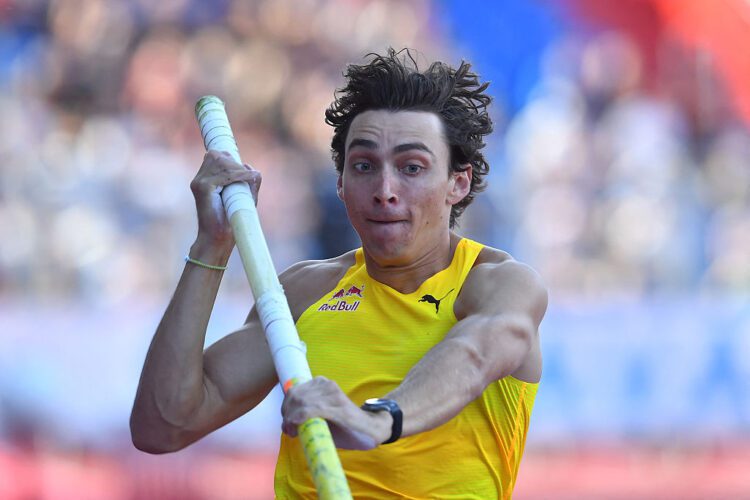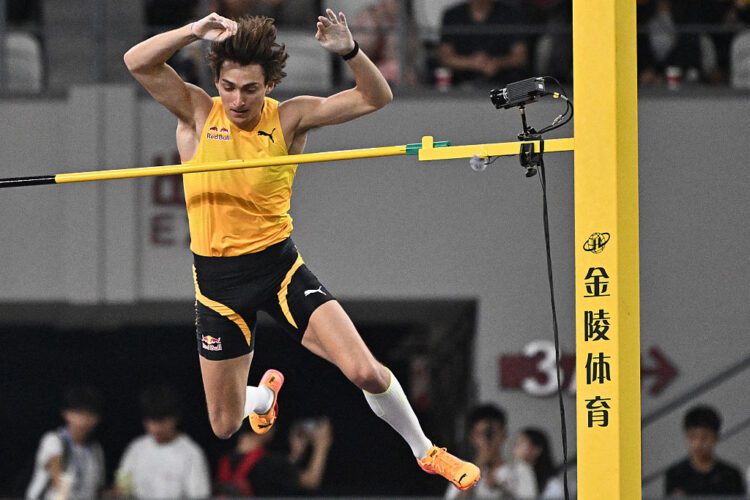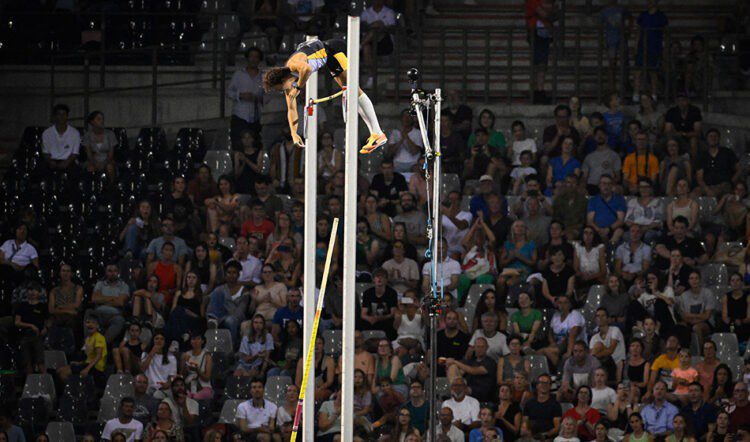His leap of 6.28m in Stockholm represented world record No.12 so far. Cathal Dennehy delves into the method behind the multiple Olympic, world and European champion’s extraordinary rise
Long before the Olympic golds, world titles and world records, Mondo Duplantis was a student of his sport – one with an insatiable appetite for improvement. If he wasn’t on the pole vault runway that his dad built in their back yard in Lafayette, Louisiana, he was often thinking about it, conjuring up ways to hoist his body ever higher.
“I daydreamed about it at school all the time, about when I was going to get home and jump,” he says. “I feel like, from a pretty early age, I figured out this is what I was going to do.”
Duplantis cleared world age bests every year between seven and 12, all of which still stand, and his 12th senior world record at the recent Stockholm Diamond League showcased again that he’s a complete outlier. But Duplantis is also something else – an innovator.
It’s 10 years since he exploded on the international stage, winning the world under-18 title in Cali, Colombia aged just 15, and much has been said and written about him since as his star went supernova. But not much of it has examined exactly what he does to jump this high, given the technical minutiae of his event are often incomprehensible to those who’ve never tried it.
To gain a better understanding, AW spoke to Duplantis and to Mitch Krier, the long-time coach and husband of Greek star Katerina Stefanidi, the 2016 Olympic gold medallist and 2017 world champion.
Most pole vaulters can be grouped into one of two jumping styles: the Russian model or French model. The former is most associated with Vitaly Petrov, who coached Ukrainian Sergey Bubka and many other champions such as Russia’s Yelena Isinbayeva and Brazil’s Fabiana Murer.
As a kid, Duplantis studied all the greats, then took what he saw out into his back yard. “I tried to imitate a lot of jumpers,” he says. “I tried jumping like Bubka, I tried jumping like Renaud [Lavillenie], like Jean Galfione, a lot of French guys – all the people I’d see on YouTube. It just kind of formed into what worked best for me.”
The Bubka/Petrov method involves driving the knee high after take-off and keeping the hands closer together on the pole but, having tried that in his youth, Duplantis felt it wasn’t right for him.
“The way that Bubka plants the pole and takes off and drives his right knee, it never really connected well with me – it wasn’t fluid,” he says. “So I kind of found more my own way of doing it and connecting with the jump.” His current technique is a “a little bit of various people”.
“I do jump very differently than Bubka. He was also quite fast but he had his fingers super shallow on [the pole]. The way we take off the ground and the way we use our legs through the jump is totally different – the motion. He drives his knee and I completely drop it and go into like a ball. ‘Tuck and shoot’, we say.”

Krier has coached pole vault for 18 years, 10 of them as a professional, and he says Duplantis’ style is “closest to the French”. Another difference he sees between Duplantis and Bubka? How they set off down the runway.
“The Russians are more about trying to set up this tall, high posture,” says Krier. “[Duplantis] is coming out accelerating from the start, but he’s able to hold on and continue to accelerate, which is the amazing part. There are people that run hard out of the back, but a lot of them die off at the end. He continues.”
Approaching take-off, Duplantis does something rare for vaulters, regardless of their favoured methodology. He drops the pole early, allowing it to contact the runway before it enters the box. Krier says the traditional approach was “always trying to drop it at the very end and time that up”, so why does Duplantis go against the grain?
“They’re finding it might be causing less reverberation in the pole when it hits the ground first,” says Krier. “He creates a full new vibration whereas, before, the pole is vibrating so much as it hits the box that those two forces can act against each other.”
However, it comes with a risk.
“A lot of the boxes aren’t necessarily flush with the track where that edge meets,” says Krier. “So learning to do that would be hard to teach, for someone to keep it on the ground and not let it pop over the box when it hits that front lip. Or when it hits the ground, it could bounce back off the ground and create all kinds of [issues].”

But it also comes with a reward.
“The amount of pressure he puts into the ground with that drop is extraordinary, to keep the pressure of the pole just right on the ground,” says Krier. “I don’t know how you would coach that.”
As for the approach on take-off, Krier says: “The Russians looked more to get the top of the pole to roll as high and as fast as it could. They’re trying to take everything as high up as they can to get the top of the pole to move fast, whereas the French or Mondo are taking advantage more of the pole bend and their body’s ability to play with that storage and elasticity. [Mondo] drops his knee and it creates a downward pressure on the bend.”
Krier says Duplantis also lowers his left arm sooner than Bubka. “Petrov wanted your left arm to stay at chest height and act as more of a fulcrum and [Mondo] is kind of guiding the pole forward with his left.”
As for the knee drop, Krier suspects its origin could be traced to Duplantis being on the smaller side as a kid. “I don’t know if it’s something he watched someone do or if he used that to figure out how to try to bend poles when he was small and keep momentum moving forward. You see that with a lot of small kids. When we start coaching, more of them than not drop that leg when they’re competitive because they want to figure out how to create some energy in the system. But the timing [of Duplantis], it’s gazelle-like. You can’t teach that position. They move in and out of it so smoothly.”
Duplantis says his height was a factor in who he mimicked as a kid. “I was quite small so it was pretty inspiring to see whatever Renaud was doing. He’s not that tall and being able to break the world record, I was like: ‘He’s gotta be doing something right here.’”
Krier believes Duplantis’s competitiveness also played a role.
“He learned to harness the body’s ability to store energy exceptionally well,” he says. “I think that was probably due to him starting young and being smaller and weaker and so competitive. If you didn’t have his competitiveness in the same situation, it doesn’t happen. If you have his competitiveness but you force him to mimic some robot move, he doesn’t store that energy and to me that’s the greatest thing he does. Every piece of his muscular system is timed with that pole.

“We always looked at the body as this two-dimensional figure and the pole as another thing that we can load. Now we’re realising it’s working in 3D and kind of torquing the body. He’s figured out how to really load up his skeletal system to react with the pole’s timing.”
Krier says Duplantis’s parents – his father Greg was a 5.80m vaulter, while his mother Helena was a heptathlete and volleyball player – were “brilliant in the amount of intervention” they did, giving Mondo “an understanding of what needs to happen as far as energy” and allowing him to figure out his optimal approach.
“A lot of pole vault coaches’ kids are really good pole vaulters and look a lot like their parents,” says Krier. “Their parents taught them the technique they knew. I don’t know that’s necessarily true with Greg and Helena.”
Krier believes nine out of 10 coaches would have “broken” Duplantis along the way, meddling with the quirkier elements of his jump like the way he drops the pole early. “So many people early on talked about changing that, the way his torso got pulled forwards. There were a lot of things that a lot of coaches probably wouldn’t have understood before they went to try to change it.”
Duplantis’s success is “definitely opening minds” in pole vault circles, says Krier. “People are looking at different things and trying to figure out why this is working so we’re not stuck with: ‘This has to be the way’. It’s a very hard thing to coach somebody to try to do that, but a lot of people might have coached that out of somebody who was doing it. Now we’re all being more careful. I’m one of the nine of 10 who probably would have messed him up many times, and it’s amazing watching his development stay on his path and what it opened up and made you understand differently.”
Krier says plenty of young pole vaulters are “starting to mimic” Duplantis and advises me to look up Cody Johnston, a 21-year-old student in Illinois with a best of 5.61m, adding that “you’ll see the little Mondo in there.”
As for Duplantis himself, does he think it’s possible for others to emulate his approach? “Of course,” he says. “I don’t think it’s that complicated. I don’t think anything’s so crazy. I think it’s a good jump and very fluid and flows nicely.”
Duplantis says he hasn’t been around enough young athletes in recent years to gauge whether others are copying his style but he adds, with a smile, “I feel like there’s worse people to try to emulate.”










